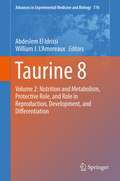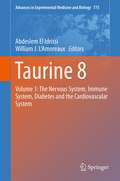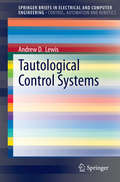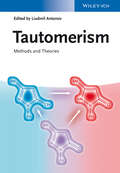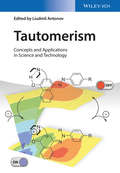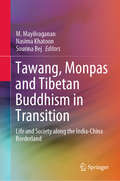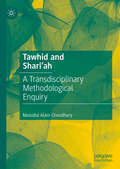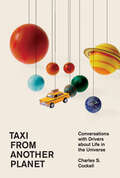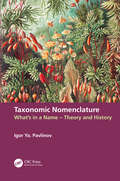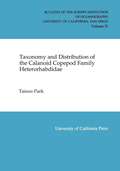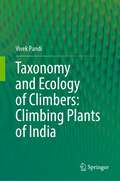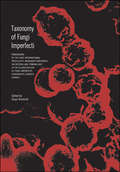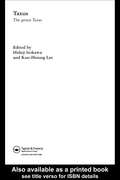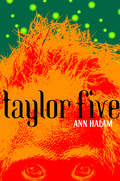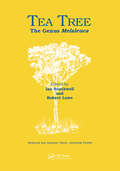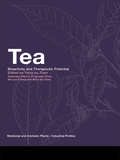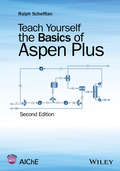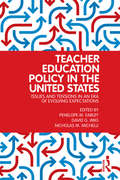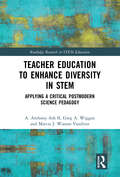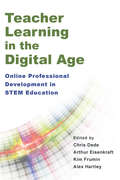- Table View
- List View
Taurine 8: Nutrition and Metabolism, Protective Role, and Role in Reproduction, Development, and Differentiation
by Abdeslem El Idrissi William J. L'AmoreauxTaurine 8 represents the combined efforts of investigators on the roles of the amino acid taurine on human health and disease. The chapters covered in this book are directly derived from presentations of the contributors at the 18th International Taurine Meeting held in Marrakech, Morocco in April 2012. The purpose of this book is to disseminate current findings on taurine's contribution in several organ systems. This book covers the following topics: Taurine in Nutrition and Metabolism, the Protective Role of Taurine, and the Role of Taurine in Reproduction, Development, and Differentiation. Dr. Abdeslem El Idrissi, College of Staten Island and Dr. William L'Amoreaux, College of Staten Island, were co-chairs of the Organizing Committee for the meeting. Data presented at this meeting provided compelling evidence that taurine is not only cytoprotective in cardiomyocytes, but also is a potent GABA agonist, whereby it can facilitate vasodilation of conducting arteries. Taurine conjugates, such as taurine chloramine, may protect cells from oxidative stress via increased HO-1 expression. In adult rodents, taurine has a potent effect on plasma glucose levels, likely through the release of insulin in pancreatic beta cells. As a potential neurotransmitter, taurine is known to work via the GABAergic system, but current research presented at this meeting suggest that taurine may interact with glutamate and serotonin receptors as well. Data are also presented to demonstrate the protective roles of taurine on neurons in neuroblastoma. Perhaps the most important and exciting presentation is the role of taurine and alcohol: the combination may be lethal. Data are also presented at this meeting of the potential role taurine may have as an adjuvant treatment with cisplatin in chemotherapy.
Taurine 8: The Nervous System, Immune System, Diabetes and the Cardiovascular System
by Abdeslem El Idrissi William J. L'AmoreauxTaurine 8 represents the combined efforts of investigators on the roles of the amino acid taurine on human health and disease. The chapters covered in this book are directly derived from presentations of the contributors at the 18th International Taurine Meeting held in Marrakech, Morocco in April 2012. The purpose of this book is to disseminate current findings on taurine's contribution in several organ systems. This book covers the following topics: Taurine in the Nervous System, Taurine in the Immune System, Taurine and Diabetes, and Taurine and the Cardiovascular System. Dr. Abdeslem El Idrissi, College of Staten Island and Dr. William L’Amoreaux, College of Staten Island, were co-chairs of the Organizing Committee for the meeting. Data presented at this meeting provided compelling evidence that taurine is not only cytoprotective in cardiomyocytes, but also is a potent GABA agonist, whereby it can facilitate vasodilation of conducting arteries. Taurine conjugates, such as taurine chloramine, may protect cells from oxidative stress via increased HO-1 expression. In adult rodents, taurine has a potent effect on plasma glucose levels, likely through the release of insulin in pancreatic beta cells. As a potential neurotransmitter, taurine is known to work via the GABAergic system, but current research presented at this meeting suggest that taurine may interact with glutamate and serotonin receptors as well. Data are also presented to demonstrate the protective roles of taurine on neurons in neuroblastoma. Perhaps the most important and exciting presentation is the role of taurine and alcohol: the combination may be lethal. Data are also presented at this meeting of the potential role taurine may have as an adjuvant treatment with cisplatin in chemotherapy.
Taurine 9
by Stephen W. Schaffer Janusz MarcinkiewiczTaurine 9 contains original articles and critical reviews based on the oral and poster presentations of XIX International Taurine Meeting held in Kraków, Poland in May 2014. The purpose of the book is to present current ideas, new avenues and research regarding biological functions and clinical applications of taurine and taurine derivatives. It focuses on all aspects of taurine research including the cardiovascular system, the immune system, diabetes, the central nervous system, endocrine system and the role of taurine supplements in nutrition. It also includes presentations of novel animal experimental models using Cdo1 and CSAD knock-out mice.
Tautological Control Systems
by Andrew D. LewisThis brief presents a description of a new modelling framework for nonlinear/geometric control theory. The framework is intended to be--and shown to be--feedback-invariant. As such, Tautological Control Systems provides a platform for understanding fundamental structural problems in geometric control theory. Part of the novelty of the text stems from the variety of regularity classes, e. g. , Lipschitz, finitely differentiable, smooth, real analytic, with which it deals in a comprehensive and unified manner. The treatment of the important real analytic class especially reflects recent work on real analytic topologies by the author. Applied mathematicians interested in nonlinear and geometric control theory will find this brief of interest as a starting point for work in which feedback invariance is important. Graduate students working in control theory may also find Tautological Control Systems to be a stimulating starting point for their research.
Tautomerism
by Liudmil AntonovCovering the gap between basic textbooks and over-specialized scientific publications, this is the first reference available to describe this interdisciplinary topic for PhD students and scientists starting in the field. The result is an introductory description providing suitable practical examples of the basic methods used to study tautomeric processes, as well as the theories describing the tautomerism and proton transfer phenomena. It also includes different spectroscopic methods for examining tautomerism, such as UV-VIs, time-resolved fluorescence spectroscopy, and NMR spectroscopy, plus the theoretical and practical background information. With its excellent overview of the methods, theories and examples, this is the perfect guide for any scientist dealing with tautomeric compounds in a wider context.
Tautomerism: Ideas And Applications
by Liudmil AntonovReflecting the substantially increased interest in tautomerism, this book demonstrates the transformation of fundamental knowledge into novel concepts and the latest applications. Each chapter introduces the theoretical background, before reviewing and critically discussing the experimental techniques and corresponding applications. Special emphasis is placed on tautomerism under unusual conditions, such as in supramolecular solids and at surfaces, displaying the wide scope between basic research and timely applications.
Tawang, Monpas and Tibetan Buddhism in Transition: Life and Society along the India-China Borderland
by M. Mayilvaganan Nasima Khatoon Sourina BejThis book presents various facets of border life in the strategic eastern sector of the India-China frontier, i.e. the Monpas of Tawang. It addresses the history of the Monpas’ transnational cultural and religious interaction. The respective chapters cover diverse topics such as culture, religion, the environment, border management, and social activism. The book offers a compelling analysis of Mon identity, their lifestyles in transition, and the reach of development politics in the Tawang borderland. It maximizes the reader's insights into development works in borderlands. This book is an essential guide for students, scholars, activists, policy makers, and anyone interested in learning about this unique geographical borderland of Monpa.
Tawhid and Shari'ah: A Transdisciplinary Methodological Enquiry
by Masudul Alam ChoudhuryThis book invokes the Tawhidi ontological foundation of the Qur’anic law and worldview, and is also a study of ta’wil, the esoteric meaning of Qur’anic verses. It presents a comparative analysis between the Tawhidi methodology and the contemporary subject of Shari’ah. Masudul Alam Choudhury brings about a serious criticism of the traditional understanding of Shari’ah as Islamic law contrary to the holistic socio-scientific worldview of the unity of knowledge arising from Tawhid as the law. A bold repudiation of the Islamic traditional understanding and the school of theocracy, Choudhury’s critique is in full consonance with the Qur’an and Sunnah. It is critical of the sectarian (madhab) conception of relational independence of facts. Thus the non-creative outlook of Shari’ah contrasts with universality and uniqueness of Tawhid as the analytically established law explaining the monotheistic organic unity of being and becoming in ‘everything’. This wide and strict methodological development of the Tawhidi worldview is articulated in this work. The only way that Tawhid and Shari'ah can converge as law is in terms of developing the Tawhidi methodology, purpose and objective of the universal and unique law in consonance with the ontology of Tawhid. Such a convergence in the primal ontological sense of Tawhid is termed as maqasid as-shari'ah al-Tawhid.
Taxi from Another Planet: Conversations with Drivers about Life in the Universe
by Charles S. CockellInsightful, good-humored essays on the possibilities of alien life and the uses of space exploration, based on an astrobiologist’s everyday conversations with his fellow humans—taxi drivers, to be precise.If you’ve ever sat in the back seat of a taxi, you know that cabbies like to talk. Sports or politics, your job or theirs, taxi drivers are fine conversationalists on just about any topic. And when the passenger is astrobiologist Charles Cockell, that topic is usually space and what, if anything, lives out there.Inspired by conversations with drivers all over the world, Taxi from Another Planet tackles the questions that everyday people have about the cosmos and our place in it. Will we understand aliens? What if there isn’t life out in the universe? Is Mars our Plan B? And why is the government spending tax dollars on space programs anyway? Each essay in this genial collection takes questions like these as a starting point on the way to a range of insightful, even poignant, observations. Cockell delves into debates over the inevitability of life and looks to both human history and scientific knowledge to consider what first contact will be like and what we can expect from spacefaring societies. He also offers a forceful argument for the sympathies between space exploration and environmentalism.A shrewd and entertaining foray into the most fundamental mysteries, Taxi from Another Planet brings together the wisdom of scientific experts and their fellow citizens of Earth, the better to understand how life might unfold elsewhere.
Taxing Choices for Managing Natural Resources, the Environment, and Global Climate Change: Fiscal Systems Reform Perspectives
by Anwar ShahThis book reviews taxing choices to protect the local and global environment and preserve and sustain natural resources. Alternative economic instruments such as carbon taxes and tradable permits to combat global climate change are also examined. Strategies and practices for the managing and sharing of revenues from natural resources are highlighted. Also, roles of various orders of government in managing, taxing, and sharing natural resources in selected countries are documented to highlight the impact of such division of responsibilities in preserving natural resources and the environment. The susceptibility of resource revenue dependent economies to corruption and malfeasance, and the Dutch disease, is also highlighted. This book could serve as a supplementary reference book for graduate and undergraduate courses and as a sourcebook for journalists, researchers, policymakers, and government practitioners.
Taxonomic Nomenclature: What’s in a Name – Theory and History
by Igor Ya. PavlinovThis book suggests an in-depth look at nomenclature in systematics instead of providing another "instruction for use" of various Codes of nomenclature. The focus is on ideas of what taxonomic nomenclature is as a part of the professional language of systematics considered in its full historical and conceptual scope. Basic concepts of nomenclature are outlined, and their development characterized; a hierarchy of fundamental principles of nomenclature are summarized; and the relationship between taxonomic nomenclature and taxonomic theory discussed. This book is addressed to those who would like to go beyond the boundaries of existing Codes to look at the subject from a more general, mostly theoretical standpoint. Key Features • Provides a review of the role of nomenclature in systematics • Reviews the conceptual scope and historical contexts of nomenclature • Analyzes fundamental principles of nomenclature • Outlines the historical development of nomenclature • Reviews the rules of nomenclature in botany, zoology, microbiology, and horticulture Related Titles Mishler, B. D. What, If Anything, Are Species? (ISBN 978-1-4987-1454-9) Pavlinov. I. Ya. Biological Systematics: History and Theory (ISBN 978-0-367-65445-0) Rieppel, O. Phylogenetic Systematics: Haeckel to Hennig (ISBN 978-0-367-87645-6) Wilkins, J. S. Species: The Evolution of an Idea, 2nd ed. (ISBN 978-0-367-65736-9)
Taxonomy and Distribution of the Calanoid Copepod Family Heterorhabdidae
by Taisoo ParkIn this revision of the calanoid copepod family Heterorhabdidae, 7 genera and 59 species are recognized and 25 species are described as new. A hypothesis of phylogenetic relationships is presented, and the geographic distribution of the species is discussed.
Taxonomy and Ecology of Climbers: Climbing Plants of India
by Vivek PandiThis book brings out the most comprehensive and up-to-date information on the taxonomy, biodiversity, and ecology of climbers in India. Climbing is one of the principal plant growth habits that have long attracted the interests of ecologists and evolutionary biologists. Climbing plants can add significantly to the species richness of many tropical forests ecosystems, yet they receive relatively lesser attention than trees in ecological studies. The difficulties in taxonomic assertions and lack of standard methodologies overlook climbers in plant inventories, resulting in the underrepresentation of climbers in regional floras. There is a growing consensus about the increasing abundance of climbers and their multifaceted role in tropical forests worldwide. Therefore, it is essential to understand the taxonomic diversity and ecology of climbers at the regional scale to substantiate our efforts towards constructing a global climber database, which serves as a reference for fundamental research in climber ecology and evolution. This book is of interest to biodiversity researchers, taxonomists, ecologists, and evolutionary biologists. Field biologists, forest managers, and naturalists will also find this a useful read.
Taxonomy of Fungi Imperfecti: Proceedings of the First International Specialists' Workshop Conference on Criteria and Terminology in the Classification of Fungi Imperfecti, Kananaskis, Alberta, Canada
by Bryce KendrickMycologists have been searching for a better system of classification of Fungi Imperfecti than that based on mature morphology. This volume documents an intensive phase of that search. It is largely an account of the proceedings of the First International Specialists' Workshop Conference on Criteria and Terminology in the Classification of Fungi Imperfecti held at the Environmental Sciences Centre of the University of Calgary, Kananaskis, Alberta. The invited contributors, all mycologists of international reputation, have had long experience with Fungi Imperfecti. The first fifteen chapters follow the course of the conference: they reproduce the formal papers and the lively discussion which followed. Chapter 16 describes a new, experimental scheme of classification distilled from the conclusions reached at Kananaskis. Four chapters concerned with the application of this scheme and with a variety of techniques now being used to extend knowledge of the Fungi Imperfecti round out the volume. The text is illustrated throughout with numerous photographs and drawings. In editing the volume, Professor Kendrick has given the text continuity by inserting short linking passages. The result is a readable and very informative account which conveys the unique atmosphere of this important conference.
Taxus: The Genus Taxus (Medicinal And Aromatic Plants - Industrial Profiles Ser. #Vol. 32)
by Hideji Itokawa; Kuo-Hsiung LeeTaxol, originally derived from the North American Yew tree in 1971, is well-known worldwide as a powerful anticancer agent. Mechanistically, it has a unique microtubule stabilizing activity, and was clinically developed as a therapeutic agent in the treatment of breast and ovarian cancers at the National Cancer Institute, Washington D.C., USA.I
Taylor Five
by Ann HalamA gripping, deeply moving adventure raises startling questions about what it means to be human. Taylor Walker seems like any ordinary 14-year-old. Ordinary—if you overlook the fact that she lives on the island of Borneo, on a primate reserve run by her parents, and knows how to survive in the jungle. Obviously, Tay isn’t just like everyone else. But she is like one other person. She’s exactly like one other person. Tay is a clone, one of only five in the world, and her clone mother is Pam Taylor, a brilliant scientist.When rebels attack the reserve, Tay escapes with her younger brother and Uncle, an exceptionally intelligent orangutan. As they flee through the jungle, Tay must look within to find her strength: Pam’s DNA, tempered by Taylor’s extraordinary life. And she looks to Uncle for guidance—for Tay knows that the uncanny bond between Uncle and herself is the key to their survival.
Tea Tree: The Genus Melaleuca (Medicinal and Aromatic Plants - Industrial Profiles)
by Robert Lowe Ian SouthwellAn up-to-date review of this popular medicinal plant genus, this book will be of interest to all those concerned with the study and use of medicinal plants and provides a comprehensive and contemporary overview of the status of tea tree.
Tea: Bioactivity and Therapeutic Potential
by Yong-Su Zhen Zong-Mao Chen Shu-Jun Cheng Miao-Lan ChenThe tea plant, Camellia sinensis, is of particular importance to humans, and the consumption of tea has a long history of over 2000 years. Currently, tea is one of the most popular beverages worldwide. In recent years the subject of tea has attracted a great deal of attention. As well as the use of tea in traditional medicine, modern biochemical re
Tea: Genome and Genetics
by Tapan Kumar MondalTea is an important non-alcoholic beverage plant of the world. Cultivation of tea is also commercially very important as it earns huge revenue for the tea growing nations especially the developing countries such as India. Although conventional breeding is well-established and contributes significantly for varietal improvement of this plant and other Camellia species with ornamental value, yet, applications of biotechnology vis a vis genomics are essential to improve the productivity and quality of the tea. This book brings out various aspects of breeding, biotechnology and genomics of tea plants. It covers i) Origin and descriptions of health benefits as well as morphological classification as first chapter, ii) Breeding and cytogenetics that comprise with various conventional approaches of varietal improvement of tea along with their genetic resources, iii) Micro-propagation which deals with in-depth study of clonal propagation, iv) Somatic embryogenesis along with alternative techniques such as suspension culture, cry-preservation etc, v) Molecular breeding that deals with application of various DNA based markers such as discovery of QTL, linkage map etc, vi) Genetic transformation and associated factors, vii) Stress physiology complied various works done in tea along with its wild relatives on abiotic as well as biotic stress and viii) Functional genomics that describes the various works of molecular cloning and characterizations, differential gene expression, high-throughput sequencing, bioinformatics transcriptomics study that described the application of next generation sequencing to discover various genes that are related to various trait of tea, Non-coding RNA which describes the discovery of various non-coding RNA in tea and related genera. The book also discusses recent developments in biotechnology such as metabolomics, proteomics, genome sequence and popular clone varieties of tea crops that are developed across the world.In conclusion, the book collates the work on tea plantations so far, identified the problems, analyzes the gaps on breeding and biotechnological works of tea as well as its wild species and discusses the future scopes as conclusion. The book aims to cover all latest information till june, 2020 . It will be useful resource for post-graduate, doctoral as well post-doctoral students working on tea as well as other woody plants. This will also be useful for the scientists working in the areas of life sciences, genomics, biotechnology and molecular biology.
Teach Yourself the Basics of Aspen Plus (Second Edition)
by Ralph SchefflanUsed for a wide variety of important scientific tasks, Aspen Plus software is a modeling tool used for conceptual design, optimization, and performance monitoring of chemical processes. After more than twenty years, it remains one of the most popular and powerful chemical engineering programs used both industrially and academically. <p><p> Teach Yourself the Basics of Aspen Plus, Second Edition continues to deliver important fundamentals on using Aspen Plus software. The new edition focuses on the newest version of Aspen Plus and covers the newest functionalities. Lecture-style chapters set the tone for maximizing the learning experience by presenting material in a manner that emulates an actual workshop classroom environment. Important points are emphasized through encouragement of hands-on learning techniques that direct learners toward achievement in creating effective designs fluidly and with confidence. <p> Designed with both students and professionals in mind, Teach Yourself the Basics of Aspen Plus, Second Edition is like having a personal professor 24/7. Its revolutionary format is an exciting way to learn how to operate this highly sophisticated software--and a surefire way for readers to get the results they expect.
Teacher Education Policy in the United States: Issues and Tensions in an Era of Evolving Expectations
by Nicholas M. Michelli Penelope M. Earley David G. ImigWhat constitutes a high quality teacher education program and what standards teacher candidates should meet before receiving their teaching credential? This volume advances deep understanding of the nature and sources of policy affecting the preparation of teachers in the U.S. and the conflicts or interconnections of these policies with the broader field of education policy. Contributions from actors in the policy world and experts representing the stakeholders are balanced and based on issues currently facing the field. Policy is viewed as evolving and political. The connection or lack thereof between policy and research is examined. Policy case studies ground the principles developed within specific chapters in practice and illustrate that policy questions and solutions are continually evolving and unsettled. Chapter-end commentaries by the editors relate the focus of each chapter to the overarching themes of the book: policy formation, policy influences, policy paradoxes, and connections to research. This volume is an essential resource for understanding and resolving today’s uncertainty and confusion over teacher education policy.
Teacher Education to Enhance Diversity in STEM: Applying a Critical Postmodern Science Pedagogy (Routledge Research in STEM Education)
by A. Anthony Ash II Greg A. Wiggan Marcia J. Watson-VandiverAddressing underlying issues in science education and teacher training, which contribute to continued underrepresentation of racial and ethnic minority students in STEM and STEAM subjects and careers, this timely volume illustrates how a critical postmodern science pedagogy (CPSP) can be used effectively to raise awareness of diversity issues amongst preservice teachers. Using a case study design consisting of class observations, interviews, content analysis, questionnaires, and instructional interventions in preservice teacher training, the volume bridges science and multicultural education and investigates how curricular development and teacher preparation can be used to ensure that science education itself promotes diversity within STEM, and throughout education. Chapters also examine the intersections of science education and science literacy for both students and teachers and, in doing so, promote the importance of positive and accurate representation of diversity within science and research discourse. The book attempts to raise awareness regarding the need for meaningful curricular reform that creates real opportunities to address historical and scientific misinformation, while increasing diversity and inclusion in schools and society. This important text will be of interest to postgraduate students, researchers, scholars, and preservice teachers in the fields of science and mathematics education, STEM, multicultural education, teacher education, urban education, and the sociology of education.
Teacher Learning in the Digital Age: Online Professional Development in STEM Education
by Arthur Eisenkraft Chris Dede Kim Frumin Alex HartleyWith an emphasis on science, technology, engineering, and mathematics (STEM) training, Teacher Learning in the Digital Age examines exemplary models of online and blended teacher professional development, including information on the structure and design of each model, intended audience, and existing research and evaluation data. From video-based courses to just-in-time curriculum support platforms and MOOCs for educators, the cutting-edge initiatives described in these chapters illustrate the broad range of innovative programs that have emerged to support preservice and in-service teachers in formal and informal settings. "As teacher development moves online," the editors argue, "it's important to ask what works and what doesn't and for whom," They address these questions by gathering the feedback of many of the top researchers, developers, and providers working in the field today. Filled with abundant resources, Teacher Learning in the Digital Age reveals critical lessons and insights for designers, researchers, and educators in search of the most efficient and effective ways to leverage technology to support formal, as well as informal, teacher learning. "Teacher Learning in the Digital Age is a superb compilation of exemplary instructional practices utilizing digital resources. This thoughtful and practical body of work can be leveraged to propel teacher and student success in the evolution of the digital classroom and school." --Mark Edwards, superintendent, Mooresville Graded School District, North Carolina
Teacher Resources: Electromagnetic Force
by Lawrence Hall of Science University of California at BerkeleyNIMAC-sourced textbook
Teacher's Guide to Using the Next Generation Science Standards With Gifted and Advanced Learners
by Cheryll M. Adams Alicia Cotabish Debbie DaileyA Teacher's Guide to Using the Next Generation Science Standards With Gifted and Advanced Learners provides teachers and administrators with practical examples of ways to build comprehensive, coherent, and rigorous science learning experiences for gifted and advanced students from kindergarten to high school. It provides an array of examples across the four domains of science: physical sciences; Earth and space sciences; life sciences; and engineering, technology, and applications of science. Each learning experience indicates the performance expectation addressed and includes a sequence of activities, implementation examples, connections to the CCSS-Math and CCSS-ELA, and formative assessments. Chapters on specific instructional and management strategies, assessment, and professional development suggestions for implementing the standards within the classroom will be helpful for both teachers and administrators.
